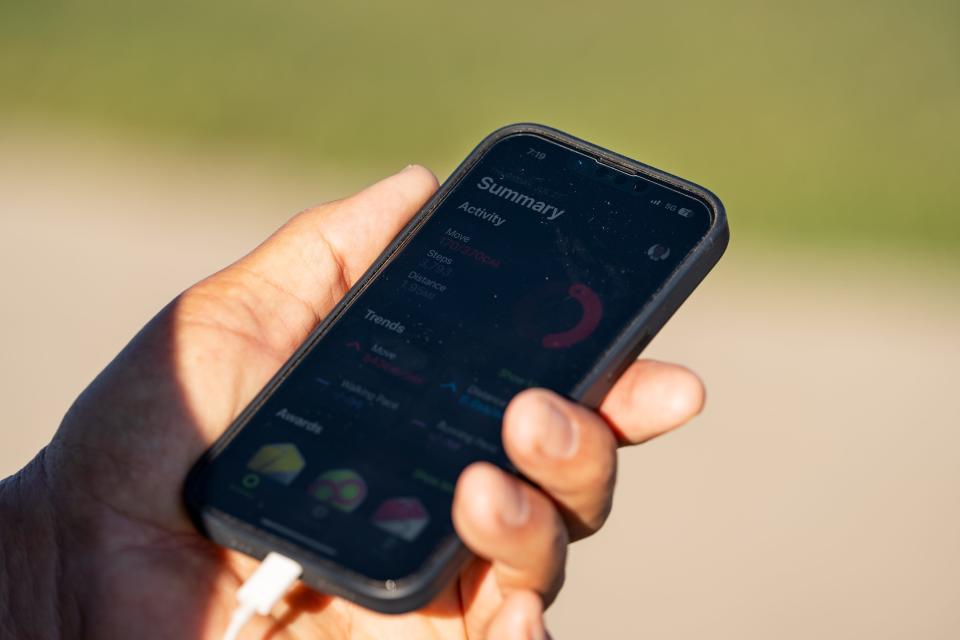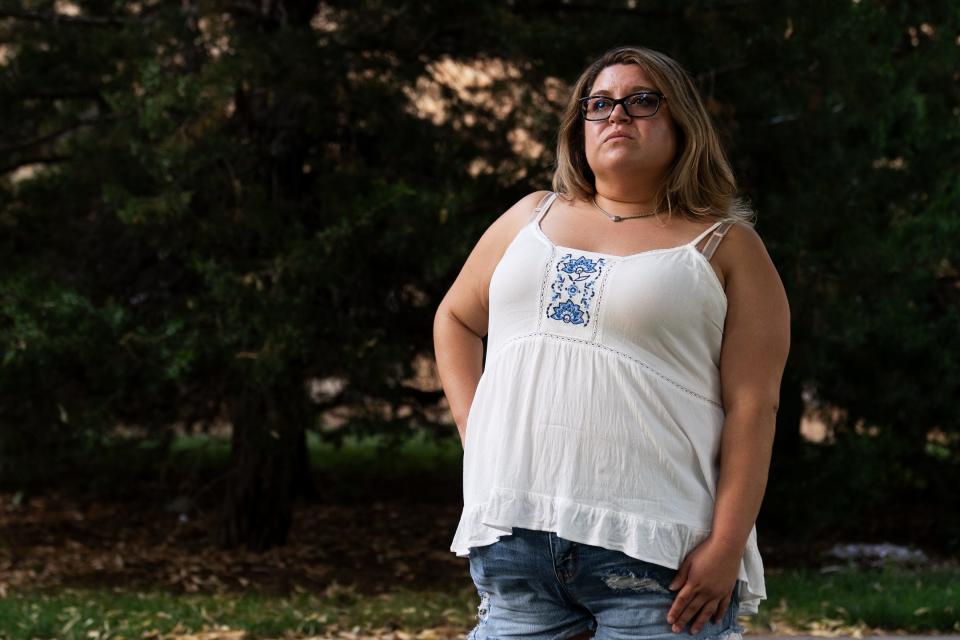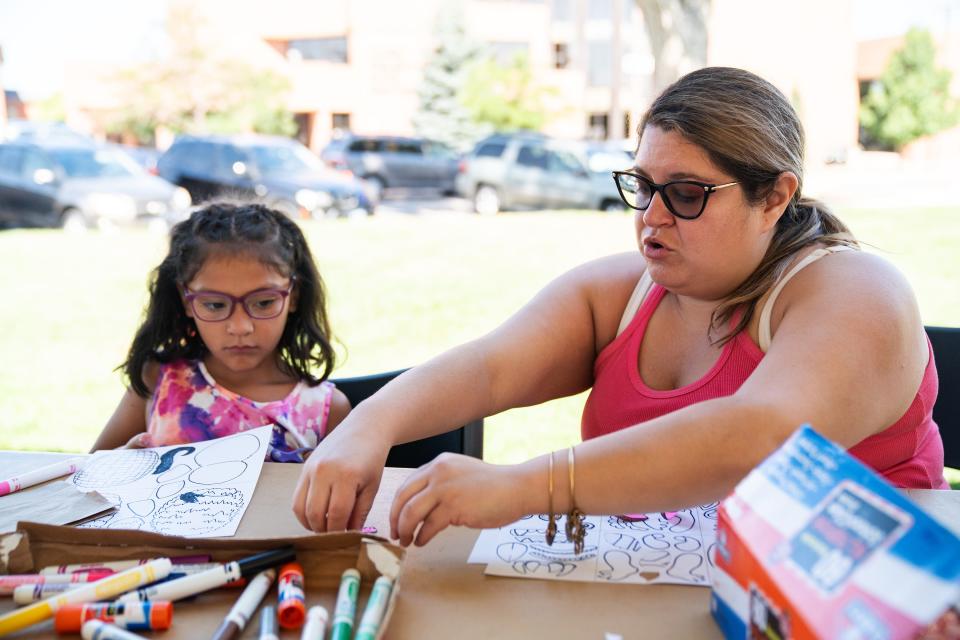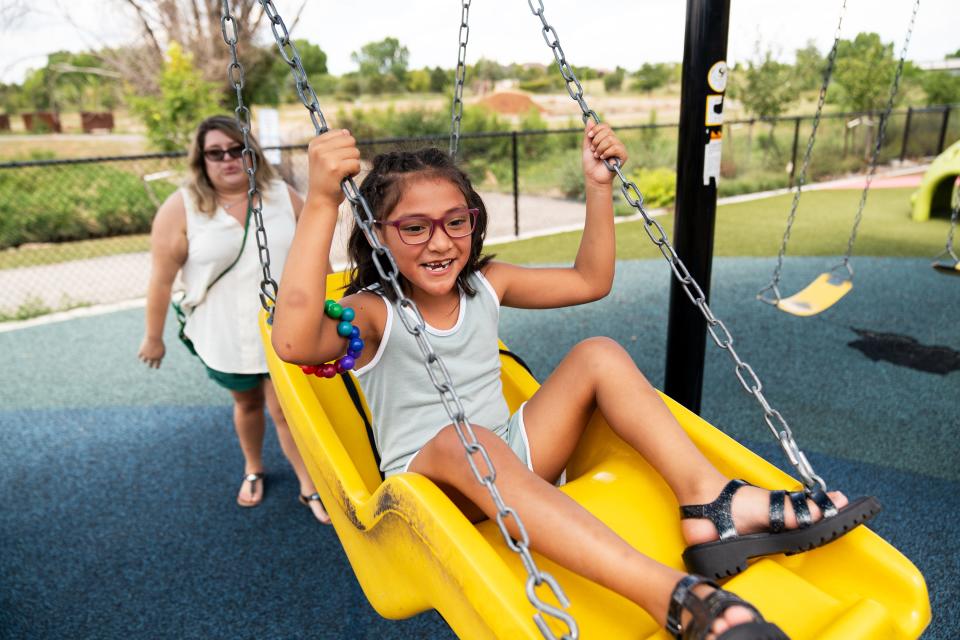This state is known for its low rate of Type 2 diabetes. It's still not enough for everyone.
Editor's note: Part three of a five-part USA TODAY series revealing why America hasn't solved its long struggle with Type 2 diabetes.
DENVER – Doug Nutter credits the abundant trails and open space near his suburban Denver home for keeping him fit and avoiding a diabetes health scare.
Further south in Towaoc, Bernadette Cuthair is desperate to bring healthier food to her Ute Mountain Ute tribe, where 1 in 4 have diabetes in a town without a grocery store.
More than an hour north of Denver, Sable Madrid works to manage her Type-2 diabetes – a life-shortening condition that claimed her mom and could threaten her 7-year-old daughter, Bella.
Colorado promotes an outdoor lifestyle, invests in parks and trails and boasts of 300 days of sunshine every year. It’s where health-conscious adults relocate to ski Aspen in the winter or hike the Chautauqua trailhead to take in the iconic Flatirons vista in the summer.
Colorado directed tobacco settlement funds to be spent on diabetes prevention and other chronic diseases and in 2019 became the first state to cap the price of insulin.
Known for its young and fit population, Colorado has the nation’s lowest diabetes rate, 8.1% as of 2022.
But there are two Colorados. In one, hiking and biking trails are filled with fitness aficionados such as Nutter and white-collar employers offer financial incentives for workers to stay healthy.
In the other, where the Ute and people like Madrid live, residents don’t have the time, means, or resources to access open space, farmer’s markets, or health clinics.
This second Colorado, said Jane Reusch, professor of endocrinology at the University of Colorado Anschutz Medical Campus, “doesn’t really look dissimilar to what’s found in Mississippi, Louisiana and Arkansas.”
Access to the great outdoors
As Nutter, 72, walked with a purposeful stride one day this summer along Clear Creek Trailhead in Wheat Ridge, Colorado, he reached yet another milestone.
Dressed in khaki cargo shorts and a Pink Floyd T-shirt, he turned down the volume on the smartphone that tracks his steps and pumps classic rock and podcasts to fuel his journey.
“That’s over 2,400 miles,” said Nutter, tanned, lean and his face lined in the right places. “Almost enough to get to New York City.”

The Arvada retiree counts every step since getting a scare from his doctor nearly two years ago. His doctor warned the retired graphics designer he was overweight. Nutter weighed 234 pounds and had a 40-inch waist. Blood tests showed his average blood sugar levels had reached “prediabetes” range.
Nutter’s answer was to walk away – from a lifetime of poor dietary habits, 35 years behind a computer and medications with unpleasant side effects.
He enrolled in a YMCA diabetes prevention program where he learned about portion control and the importance of exercise. For one year, he charted every meal and counted every gram of fat.
Program instructors urged him to get 2.5 hours of exercise a week. He decided he'd get that much every day.
The Diabetes Dilemma
Type 2 diabetes rates continue to climb, despite well-known treatments and prevention approaches. To better understand why, USA TODAY's health team traveled across the country, talking to researchers, clinicians and patients. They found people with diabetes often must fend for themselves against systemic barriers and a difficult disease.
He’s shed 45 pounds and 4 inches from his waist. His improved health allowed him to discontinue medication for borderline high blood pressure. His blood sugar levels are within normal range.
He no longer counts every calorie, but he weighs himself daily and makes changes as needed. His wife, a former aerobics instructor also with prediabetes, has joined him on his fitness quest. They often share meals at restaurants instead of ordering two entrees. And at a party, a couple of bites of a cake is enough, no need for a full slice.

The cornerstone of Nutter’s regimen is his daily walks, and he credits the state's and metro-Denver's hiking trails, parks and open space for changing his life and keeping him motivated.
In the mid-2010's, then-Gov. John Hickenlooper called for an expansive network of 16 hiking and biking trails that would put every resident within a 10-minute walk of green space. While that fully connected state hasn’t yet been achieved, it illustrates the state’s efforts to make sure people have options to stay fit.
“Having those trails is definitely a benefit,” said Nutter, who expects to reach his new walking goal of 2,982 miles, the equivalent of Los Angeles to Boston, by mid-November. “If people don’t have that, then it’s going to hamper their ability to get out and exercise.”
Eating in a food desert
For decades, the tiny Ute Mountain Ute tribe in Towaoc has grappled with diabetes. Located between the Four Corners National Monument and Mesa Verde National Park, the tribe tracks each case of diabetes among members who get care through the Ute Mountain Ute Health Center, an Indian Health Services clinic.
Of the nearly 1,100 members on the reservation in Towaoc and nearby White Mesa, Utah, 292 have Type 1 or Type 2 diabetes, said Rita King, the tribe’s diabetes prevention coordinator, more than twice the national rate. The tribe doesn’t track cases among the 1,000 members who live off the reservation and don’t rely on IHS for health care.
“Our numbers have risen, especially during the time COVID hit, because everyone was home and we weren’t allowed to go to the grocery store,” King said. “People were eating whatever was available, even if it was unhealthy.”
More in series: American can prevent (and control) Type 2 diabetes. So why aren’t we doing it?
The post-pandemic malaise has continued, King said, with some members reluctant to get outdoors and kids content staying home after school to play video games. Rising prices for fresh fruits and vegetables – a nutritional lifeline for those who need to control their blood sugar – are too much to afford, let alone access.
A true food desert, the closest grocer is in Cortez, Colorado, a 20-plus minute drive along U.S. 491.
The tribe wants to open a grocery store to diversify fresh food options and supplement the reservation’s agriculture enterprise, an irrigated farm on desert land that grows award-winning corn. But that will take time and money, said Bernadette Cuthair, the tribe’s planning and development director.
More in series: Diabetes runs deep in rural Mississippi. Locals have taken to growing their own solutions.
“The vision is big,” Cuthair said. “However, it’s dictated by dollars.”
The tribe has received a Department of Commerce grant. Plans call to begin with a farmer’s market, then build storage units that can be leased by vendors who could sell fruits and vegetables, bakery items and other fresh foods.
Cuthair knows the importance of eating healthy. The 61-year-old first learned she had the most common form of diabetes, Type 2, when she was 28. Her father managed his diabetes with regular insulin doses, but her mother and sister both were on dialysis.
She's optimistic her own dietary changes and dramatic weight loss – she's dropped 139 pounds over the past two years – can extend her life and set an example for others.
"We all want to live," Cuthair said. "It just depends on the choices you make."

Bridging the divide
Colorado health officials are seeking to bridge the divide between the two Colorados. A key part of that is encouraging residents like Nutter to take charge of their health, and assisting at-risk populations to overcome barriers.
The YMCA program that guided Nutter’s weight loss is one of three diabetes prevention programs in Colorado. The goal: Help people avoid harmful and expensive diagnoses while there’s still time to make a difference.
An estimated 96.3 million Americans have “prediabetes,” when A1C levels are so high that they could develop full-blown diabetes without lifestyle changes. The Centers for Disease Control and Prevention approves curriculums for programs such as the YMCA's that aim to change the health course of millions of Americans.
But prevention reaches just a fraction of eligible people. Just over 690,000 Americans are enrolled in such programs as of July, according to a CDC report.
"Type 2 diabetes is preventable," said Becky Diorio, a diabetes and health navigation program manager at the Colorado Department of Public Health and Environment. "The more that we invest in prevention, the more we're going to reduce health care costs and complications down the line."

Colorado does better than most states. Only seven states enrolled more than Colorado’s nearly 25,000 in prevention programs as of July 2023, according to the CDC. Colorado had more people sign up than even much larger states such as New York and Pennsylvania.
Colorado’s outdoor lifestyle inspires some to exercise and stave off diabetes, Diorio said.
“The combination of healthy active lifestyles and lower obesity rates definitely contributes to why our rates in Colorado are lower,” Diorio said.
Colorado health officials have sought to raise awareness about prevention with doctors and other providers who care for at-risk patients. The YMCA program is available to adults 18 and over who are at risk of diabetes. Costs are covered by Medicare for many older adults, and the YMCA offers scholarships for some participants.
The stakes are high – in Colorado and nationwide.
Beyond the enormous health toll, diabetes represents a major financial burden. About $1 in every $4 Medicare spends is related to diabetes care. Half of the first 10 drugs that Medicare has targeted as the most expensive are used to treat diabetes. And while the Biden administration has sought to make things easier by capping out-of-pocket costs for insulin, that hardly gets at the true costs families with diabetes must handle.
“There's been a lot of noise lately about trying to lower the price of insulin – and that's great,” Reusch said. “But the cost of living with diabetes is so much more than insulin.”
Kattia Blanco, a YMCA manager of health and wellbeing who teaches Spanish diabetes prevention classes, said the classes are valuable because the Latino population in metro Denver has a higher rate of diabetes than the state overall. She said some first-generation families that have relocated to Denver from Latin American countries have adopted a different lifestyle - driving more, walking less and eating less healthier meals.
More in series: The steep cost of Type 2: When diabetes dragged her down, she chose to fight
Many newcomers also immigrate for economic opportunity, so they don’t prioritize a work-life balance.
"There's a lot of people who just need to work and they forget about themselves," said Blanco, a native of Costa Rica.
Despite Colorado’s reputation for beautiful hiking trails, Alejandra Lopez, who lives and works in Southwest Denver, said it’s not easy for people in her largely immigrant neighborhood to hike, ski, or get to the gym.
Exercise and outdoor activities can be “more of a privilege because some families don’t have the time, the transportation or the knowledge (of where to go)," she said.

Stopping the cycle
Sable Madrid has spent her life in Greeley, Colorado, a fast-growing city just over an hour north of Denver. Greeley is the hub of Weld County, which had a diabetes rate of 11.4% in 2019 – nearly double the state’s average that year.
Madrid discovered she had Type 2 diabetes at 13, just a couple of weeks after her mother, Nadine, was diagnosed with it, too.
“When you’re 13, and you find out your whole life is going to change, that it’s something that will kill you, it’s daunting,” she said.
More in series: Solutions exist to end the Type 2 diabetes dilemma but too few get the help they need
Madrid quickly learned she would face medical complications, possible heart and kidney trouble in middle age, and a life that on average ends 15 years sooner than someone without diabetes.
Madrid immersed herself in research. Her middle school and high school science fair projects examined how diabetes ravages the body. Her readings all recommended a healthy diet, reducing stress, and self-care.
But that’s not what she saw around her.
Her mother and other relatives would tell her a “good Latin never turns down work,” Madrid said. “And my mother would just work herself to the bone.”
A hairdresser, her mother spent long hours on her feet, even into her 50s, outworking stylists half her age. Ten-hour shifts at the salon were routine.
COVID-19 upended that schedule. The lockdowns of 2020 meant she couldn’t work. Her diabetic complications worsened. Sitting for longer left her with feet that could no longer support her. Infections followed.

She was too sick to attend Bella’s first day of kindergarten two years ago. Weeks later, she was hospitalized for the last time. The 61-year-old died in September 2021.
Reusch, the endocrinology professor, said people still blame those with diabetes for their own disease, a stigma that doesn’t exist with other conditions. While people might rally around a person who gets cancer, such communal support is rare in diabetes.
“The assumption is, well, you chose to be inactive and overweight or obese, this is your problem,” Reusch said.
Though Madrid knows her mother did not prioritize self-care, she’s determined to make different dietary and lifestyle choices, so she’ll be there for Bella.
Madrid exercises and eats healthy foods. She advocates for herself at the doctor’s office to make sure she’s on the right medications. She goes to counseling to grapple with the loss of her mother and the road ahead for her and Bella.

On a recent afternoon, when a medical appointment required the hour-plus drive from Greeley to Denver, they made a day of it. Nearly an hour on the playground running and jumping, then stops at a bookstore and toy shop at Stanley Marketplace in Aurora.
“I need to focus on what can I do to make my child's life better," Madrid said, "and what can I do to make my life better.”
This story is part of a reporting fellowship sponsored by the Association of Health Care Journalists and supported by the Commonwealth Fund.
This article originally appeared on USA TODAY: Colorado's diabetes rate is lowest in US. That's only half the story.


